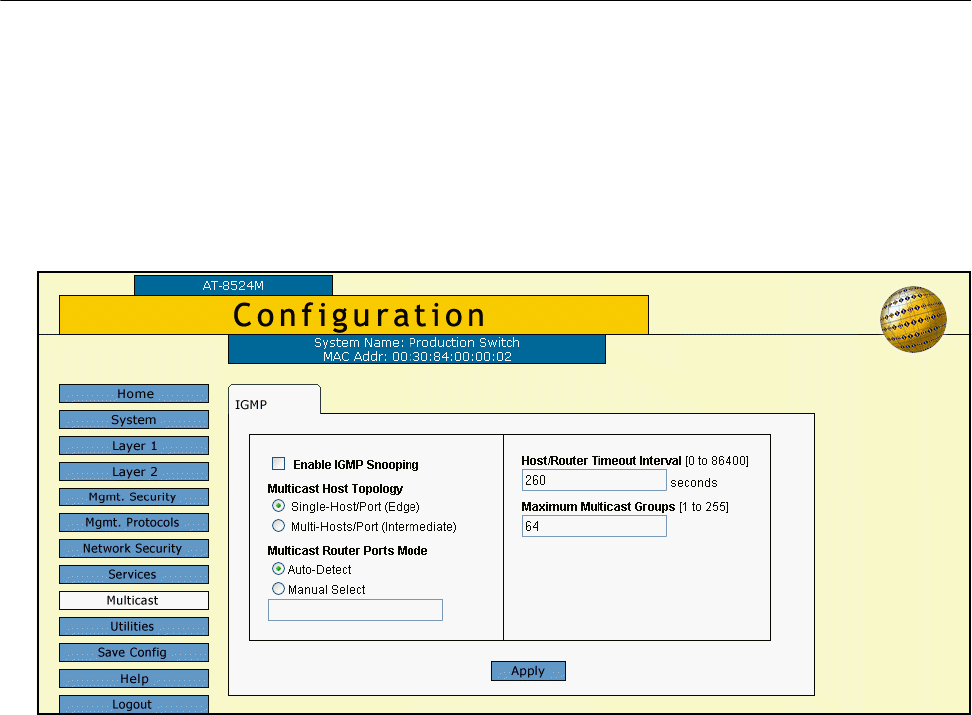User Manual
Table Of Contents
- Contents
- Figures
- Preface
- Section I
- Basic Operations
- Chapter 1
- Starting a Web Browser Management Session
- Chapter 2
- Basic Switch Parameters
- Chapter 3
- Enhanced Stacking
- Chapter 4
- SNMPv1 and SNMPv2c Community Strings
- Chapter 5
- Port Parameters
- Chapter 6
- MAC Address Table
- Chapter 7
- Static Port Trunks
- Chapter 8
- Port Mirroring
- Section II
- Advanced Operations
- Chapter 9
- File System
- Chapter 10
- File Downloads and Uploads
- Chapter 11
- Event Log and Syslog Servers
- Chapter 12
- Classifiers
- Chapter 13
- Access Control Lists
- Chapter 14
- Quality of Service
- Chapter 15
- Class of Service
- Chapter 16
- IGMP Snooping
- Chapter 17
- Denial of Service Defense
- Chapter 18
- Power Over Ethernet
- Section III
- SNMPv3 Operations
- Chapter 19
- SNMPv3
- Enabling the SNMP Protocol
- Configuring the SNMPv3 User Table
- Configuring the SNMPv3 View Table
- Configuring the SNMPv3 Access Table
- Configuring the SNMPv3 SecurityToGroup Table
- Configuring the SNMPv3 Notify Table
- Configuring the SNMPv3 Target Address Table
- Configuring the SNMPv3 Target Parameters Table
- Configuring the SNMPv3 Community Table
- Displaying SNMPv3 Tables
- Section IV
- Spanning Tree Protocols
- Chapter 20
- Spanning Tree, Rapid Spanning Tree, and Multiple Spanning Tree Protocols
- Section V
- Virtual LANs
- Chapter 21
- Port-based and Tagged Virtual LANs
- Chapter 22
- GARP VLAN Registration Protocol
- Chapter 23
- Protected Ports VLANs
- Section VI
- Port Security
- Chapter 24
- MAC Address-based Port Security
- Chapter 25
- 802.1x Port-based Network Access Control
- Section VII
- Management Security
- Chapter 26
- Encryption Keys, PKI, and SSL
- Chapter 27
- Secure Shell Protocol
- Chapter 28
- TACACS+ and RADIUS Authentication Protocols
- Chapter 29
- Management Access Control List
- Index

Chapter 16: IGMP Snooping
184 Section II: Advanced Operations
Configuring IGMP Snooping
To configure IGMP snooping from a web browser management session,
perform the following procedure:
1. From the Home Page, select Configuration.
2. Select the Multicast menu option.
The IGMP tab is shown in Figure 52.
Figure 52. IGMP Tab (Configuration)
3. Adjust the IGMP parameters as necessary.
The parameters are explained below:
Enable IGMP Snooping
Enables and disables IGMP snooping on the switch. A check in the
box indicates that IGMP is enabled.
Multicast Host Topology
Defines whether there is only one host node per switch port or multiple
host nodes per port. Possible settings are Edge (Single-Host/Port) and
Intermediate (Multi-Host/Port).
The Edge (Single-Host/Port) setting is appropriate when there is only
one host node connected to each port on the switch. This setting
causes the switch to immediately stop sending multicast packets out a
switch port when a host node signals its desire to leave a multicast
group by sending a leave request or when the host node stops sending
reports and times-out. The switch forwards the leave request to the










